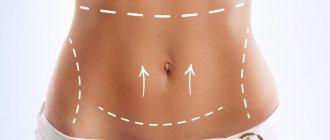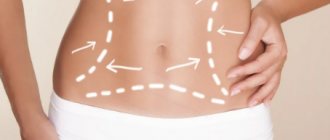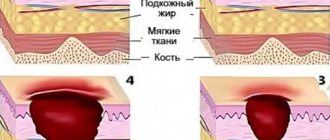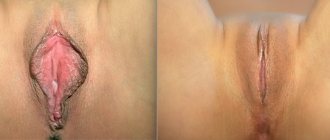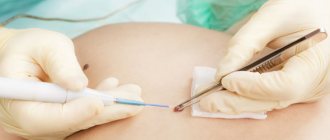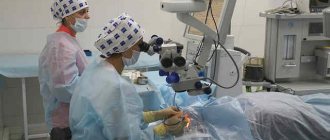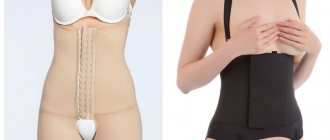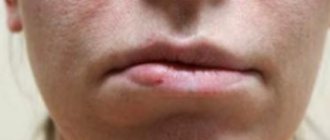A saggy and large belly is every woman’s nightmare. Pregnancy, childbirth, excess weight, a number of diseases or age-related changes, all this can greatly affect a woman’s figure. Getting back a beautiful athletic belly is not so easy. Even grueling workouts cannot help get rid of stretched skin. It is in such cases that plastic surgeons come to the rescue. The only way to get rid of the hated “ballast” is through surgery. The Correct Clinic performs tummy tuck - abdominoplasty.
What is abdominoplasty
Modern plastic surgery can correct almost any defect in the human body. A sagging belly, despite the complexity of the operation, is not a problem that plastic surgeons cannot cope with. About 7% of all plastic surgeries performed are aimed at eliminating this body defect.
Abdominoplasty is an operation whose purpose is to eliminate excess accumulation of subcutaneous fat and excess skin on the abdomen. In addition, during plastic surgery, the abdominal wall muscles are tightened.
Methods and technologies of modern plastic surgery make it possible to reduce the risks of complications during surgery and during the rehabilitation period to a minimum. An important point is the correct choice of clinic and specialist. At the Corrective Abdominoplasty center, the best plastic surgeon for abdominoplasty performs it.
Types of abdominoplasty
The following types of abdominoplasty are distinguished:
- classical;
- through a vertical cut;
- tense-lateral;
- mini abdominoplasty;
- endoscopic;
- abdominoplasty after childbirth;
- elimination of diastasis;
- combined with liposuction.
Classic abdominoplasty
The most common and difficult operation. Indications are unremovable skin-fat apron or large fat deposits on the abdomen.
Incisions are made horizontally around the navel and above the groin. Next, excess fatty tissue is removed, the skin is pulled up so that the new navel has the correct location.
Abdominoplasty through a vertical incision
This type is less traumatic; the incision is made along the midline (sometimes, due to fat, it can reach the sternum). Excess tissue is removed, and the skin is shifted from the sides to the middle. The abdomen is completely tightened. After removing excess fat, the navel is correctly fixed and the muscles are stitched layer by layer in the correct position.
The main disadvantage is the presence of a vertical scar from the navel to the pubis. However, he can easily cover himself with underwear.
Tight lateral abdominoplasty
The method is distinguished by the formation of a narrow waist, even if it did not exist before. After excision of all excess, the doctor pulls the abdominal wall down and to the side. Incisions are made along the side lines to shape the waist. This creates a right angle between the vertical axis and the direction of tension. This gives tissue tension. It may be necessary to remove 1-2 lower ribs. The main disadvantage of the procedure is the noticeable seam.
Mini abdominoplasty
The least traumatic type, allows local anesthesia. This method is indicated in unadvanced mild cases. A small incision is made just above the pubis (up to 10 cm maximum), through which a small area of skin is removed.
Mini abdominoplasty only affects the lower abdomen up to the navel (the navel is not affected). The rehabilitation period is minimal, and the scar is invisible.
Who needs abdominoplasty
Not everyone needs to resort to plastic surgery to remove their belly fat. The operation is primarily recommended for those people who cannot restore their abdominal muscles even with constant training. The main problem with which people turn to plastic surgeons is not the absence of abs and the presence of a small tummy, but a specific problem with a fatal weakening of the abdominal muscles and the presence of a pathological area of sagging abdominal skin. This pathology is caused by: a number of diseases of the gastrointestinal tract and endocrine system, obesity and the consequences of pregnancy.
Direct indications for abdominal tummy tuck:
- discrepancy in the abdominal region of the rectus muscles, with accompanying skin stretch marks;
- the patient has excess fat deposits (provided there is no effectiveness from conservative methods);
- the presence of pronounced scars after surgery;
- sagging and lack of elasticity of the skin on the abdomen;
- the presence of a skin-fat “bag”.
Abdominoplasty in Moscow in our clinic may be recommended for medical reasons in the presence of an umbilical hernia with concomitant abdominal enlargement.
Complications after abdominoplasty:
Any surgical intervention is associated with a certain risk of complications. Their development can be significantly reduced by carefully following the doctor’s recommendations in the pre- and postoperative period. Particular consideration should be given to the need to perform surgery in patients with concomitant diseases and smokers, as this is associated with an increased risk of complications. However, some of the possible complications are genetic and highly individual. Therefore, a qualified plastic surgeon will always tell you about the possible consequences during the preliminary consultation.
Among the complications of the early postoperative period, the appearance of hematomas and seromas is possible. To prevent them, drainage tubes are installed during abdominoplasty. In some cases, residual serous fluid can later be removed by puncture with a syringe through the skin. Wearing compression garments prevents the formation of seromas.
Excess scarring may develop at the incision site when the patient tends to develop hypertrophic or keloid scars. To prevent excessive scarring in the postoperative period after removal of sutures, it is necessary to rub in anti-scarring medications that the doctor will recommend to you.
Contraindications
Having seen what the patients of our clinic look like after abdominoplasty in the photo before and after the operation, the desire to undergo surgery arises in 90% of people who have this problem. However, surgery performed to correct the abdomen may not be recommended for everyone.
Since plastic surgery involves manipulation by a surgeon, there is a list of absolute contraindications:
- endocrine pathologies;
- connective tissue diseases of a systemic nature;
- diseases of the cardiovascular system;
- deviations in the process of blood clotting;
- heart or pulmonary failure.
There is a list of relative contraindications:
- exacerbation of chronic or infectious diseases;
- planned future pregnancy;
- smoking or addiction to alcohol;
- pathological addiction to food.
Relative contraindications to abdominal correction with abdominoplasty can be eliminated, after which the surgeon agrees to plastic surgery.
Operation methods
The cost of abdominoplasty depends on the volume and complexity of the surgeon’s work, as well as the method of performing the plastic surgery.
Abdominal correction methods:
- mini-abdominoplasty - performed when it is necessary to plasticize only the lower wall of the abdominal tissues, when there is an indication for skin tightening;
- classic - in addition to removing fat and skin, the surgeon performs a muscle tightening in the abdominal area (removing the navel is required);
- endoscopic - this method is not suitable for abdominoplasty of the large abdomen, since it involves suturing only the abdominal muscles, without correcting excess skin.
Depending on the existing defects, which the specialist identifies during the consultation, the procedure for performing the operation is determined.
Preparation
Any surgical intervention requires preparation for the operation; abdominal correction with abdominoplasty is no exception. Before undergoing plastic surgery, the patient undergoes a complete diagnosis. If there are no contraindications, the surgeon will conduct a consultation on the specifics of the preparatory stage, which will last from two weeks to a month.
Recommendations in the preoperative period:
- giving up bad habits (smoking and drinking alcohol);
- stop taking hormones if possible;
- avoid taking any medications that affect the blood clotting process;
- dieting (weight loss if necessary);
- reduction of physical and psycho-emotional stress;
- 8–12 hours before surgery, avoid eating.
Directly on the day of surgery or a few days before plastic surgery, the patient consults with an anesthesiologist to determine the specifics of induction into general anesthesia.
General complications
Overload of the pulmonary circulation
The result of the complication is pulmonary edema, as a consequence of increased intra-abdominal pressure.
Intra-abdominal pressure can result from widespread suturing of the rectus abdominal wall muscles, which leads to a sharp decrease in the volume of the abdominal cavity.
This complication is very rare, however, it must be remembered that too aggressive suturing of diastasis of the muscles of the anterior abdominal wall can be risky.
The best way to prevent this complication is to train with a compression bandage for two to three weeks before surgery.
Hypostatic pneumonia and pulmonary embolism
These complications are a consequence of the patient's physical inactivity during a long operation and in the early postoperative period.
To prevent these dangerous complications, the patient wears special compression stockings (hospital stockings) before surgery. The stockings provide dosed compression over the entire surface of the leg, significantly improving venous outflow, which dramatically reduces the likelihood of blood clots.
In addition, if necessary, the patient is given a subcutaneous injection of a drug such as Fraxiparine, which reduces the activity of blood clotting factors, thus reducing the risk of blood clots.
Early activation of the patient after surgery is also one of the main measures to prevent these complications. The patient begins to walk the next day after surgery, bending slightly to avoid tension in the area of the postoperative suture.
Patients with impaired blood clotting in the direction of hypercoagulation should be prescribed therapy aimed at preventing thromboembolic complications. In this case, the operation can be performed only if blood clotting parameters are normalized.
Diagnostics
It is possible to remove the abdomen surgically not only if the specialist agrees to the operation, but also if the patient has no contraindications.
To obtain information about the clinical picture of the patient’s health, tests are prescribed:
- OA of blood and urine;
- donating blood for clotting, the presence of PPP diseases, hepatitis, group and Rh factor;
- blood donation: biochemistry and coagulogram.
A hardware examination is also carried out: ECG and x-ray or fluorography. The surgeon also asks the patient about previous diseases, possible allergic reactions to drugs and hereditary predisposition to any pathologies.
Operation scheme
At the Correct Clinic you can see photographs of what patients who have undergone abdominoplasty look like before and after correction. The visual effect confirms how difficult the work is required of the surgeon.
The technique of plastic surgery for abdominal correction affects the course of the procedure, but the main stages are similar. The duration of the operation is from 1 to 5 hours.
The most difficult method is considered to be classic abdominoplasty. It lasts for more than 4 hours. During the surgical procedure, manipulations are performed: an incision with a scalpel in the soft tissue around the patient's navel. The incision is directed from the navel to the suprapubic area. Next, the doctor lifts the skin layers, separates the fatty tissue, and performs an aponeurosis. The next step is to shape the navel and remove excess tissue. Upon completion, the location of the navel is fixed and sutures are applied.
Mini abdominoplasty begins with an incision above the bikini area. Fat tissue removal is not performed. The surgeon's job is to remove excess skin and create a new shape for the abdomen. Used for people who are not obese. It turns out to be effective for the consequences of pregnancy or significant weight loss.
The endoscopic abdominoplasty method involves performing an operation without performing direct surgical intervention. The procedure involves inserting instruments and a miniature camera through three small incisions into the patient's abdomen. The surgeon fixes the muscle tissue. Additionally, liposuction can be performed. However, the skin is not removed.
On the clinic’s website you can read reviews about abdominal tummy tuck and its effectiveness, as well as see what patients look like after abdominoplasty in the photo.
Suture after abdominoplasty
The larger and larger the plastic surgery, the more undesirable consequences and side effects it has. In the case of a tummy tuck, a separate problem is the long surgical incisions, after which the skin will never be completely smooth.
The suture after abdominoplasty heals under conditions of strong tissue tension - because of this, in the first months the scar looks extremely unsightly, takes a long time to mature, and even after a long time it can break apart or become inflamed. Is it true that the scar will remain for life and will have to be hidden from prying eyes? What to do if outwardly he turns out to be completely inappropriate? Is it possible to speed up and facilitate the healing process? TecRussia.ru tells the details for those who are ready to make the necessary sacrifices for their beauty:
↑ What marks will remain on the stomach after abdominoplasty?
The total volume and technique of the operation depend mainly on the amount of excess skin and fatty tissue, as well as the presence of concomitant surgical diseases of the anterior abdominal wall in the patient (muscle separation, inguinal or umbilical hernia, etc.) The more tissue the surgeon needs to remove, the more the longer the incisions will be, and the more difficult it will be for the patient during the rehabilitation period.
| Type of abdominoplasty | Where and what will the seam be? |
| Classic abdominoplasty | The skin is incised horizontally across the entire abdomen - at the level of the pubis and protruding pelvic bones. If there is significant sagging, you will need an additional incision around the navel to move it to a new place - it may look like a circle, an inverted Y or U (the latter option is the least noticeable). |
| Vertical | This technique is used when the patient has diastasis of the rectus abdominis muscles, as well as significant excess skin after severe weight loss. For best results in this case, two incisions will be needed. One is horizontal, just like with classic abdominoplasty. The second is vertical, along the midline of the abdomen to the sternum. |
| Lateral | Here, too, there will be a main horizontal seam along the lower abdomen, but in addition to it there will be two additional ones, they are located on the sides. This technique allows you to remove excess fatty tissue around the entire circumference of the body (except for the back), as well as from the “buns” area on the lower back and tighten the outer surface of the thighs, due to which the waist becomes more pronounced and clear. |
| Extended | In this version of the operation, the entire hip area is additionally tightened. The basic incision extends from the abdomen to the sides and may extend well beyond the prominent portions of the ilia. |
| Circular | The most difficult option for a tummy tuck for both the plastic surgeon and the patient. It involves the removal of excess skin and fat not only from the anterior and lateral abdominal wall, but also from the outer surface of the thighs, and from the back in the lumbar region. The scar remains circular, running along the abdomen, sides and back of the torso. |
| Mini abdominoplasty | The incision is made in the suprapubic region (along the bikini line), horizontally. It will be somewhat shorter than with a classic operation: usually its length does not exceed 20 cm, and this is enough to remove a small excess of tissue and perform liposuction of the abdomen, sides and upper third of the thighs. |
Approximately 1 year after abdominoplasty, a correct, healed suture without complications looks like a fairly thin light-colored thread. It won't be very noticeable, but it won't be completely invisible either.
↑ Features of scarring after abdominoplasty
Surgical incisions in the lower abdomen heal in the same way as any other soft tissue injuries (for more details, see the article “Stages of scar formation”). But there are several factors that inevitably complicate this process:
- Drainage tubes may remain in postoperative wounds for several days;
- flaps of skin and subcutaneous tissue are under great tension (in many “before and after” photos of abdominoplasty you can see that the final scar in the middle looks wider than on the sides - the reason is precisely that closer to the center it stretches with the greatest force);
- in the immediate vicinity of the injured area there are abdominal muscles, even small contractions of which can lead to suture divergence;
- due to the overall complexity of the operation, the likelihood of suppuration, tissue necrosis and the development of other complications increases.
| Photo of the seam after abdominoplasty |
The greatest problems are usually caused by tissue tension, which will be especially strong in the first 1-2 months. For abdominoplasty, this condition is the norm, since a flat tummy is obtained only by excision of excess skin and fat in a sufficiently large amount. As a result, the postoperative scar is formed under very unfavorable conditions:
- At the stage of epithelization there is a high risk of divergence of the wound edges. In addition, stretched skin and soft tissues, and sometimes suture material, put pressure on the vessels, which creates the risk of developing necrosis (death) of large areas, and also slows down the process of formation of connective tissue and fusion of skin flaps.
- At the stage of a “young” scar (it begins approximately 2 weeks after tummy tuck), blood flow is more or less restored, but a new problem appears: constant tension on the skin flaps leads to excessive formation of fibroblasts and connective tissue fibers, due to which the scar often grows wide, convex and hard to the touch. Here, physiotherapeutic procedures or the use of special ointments/gels are almost always necessary, otherwise gross scarring will easily reduce the overall aesthetic result of the operation to zero.
To reduce the likelihood of suture dehiscence and facilitate its healing, for at least a month after surgery you will need to:
- walk slightly bent over and sleep with your legs crossed;
- avoid any physical activity, especially those that require contraction of the abdominal muscles;
- do not lift anything even remotely heavy;
- exclude any foods that can cause bloating and flatulence;
- give up any sports activities.
You will need to return to physical activity and usual sleeping positions very carefully and only after the approval of your surgeon.
↑ How to care for a seam so that it becomes as invisible as possible
Normally, changes in the appearance of the scar after tummy tuck will occur as follows:
| Time after plastic surgery | What's happening |
| 1 month | By this time, the wound should be completely healed. Due to increased blood flow and active collagen production, the scar will appear swollen, ranging in color from bright red to dark burgundy. It is worth preparing for the fact that in the next few months its appearance will not improve at all, moreover, there may be a tendency to worsen. |
| 6 months | The color remains red and the shape remains convex, but by this point positive changes should begin. Part of the fibrous tissue is destroyed, blood flow is reduced, due to this the seam should gradually begin to lighten and become flatter. |
| 1 year | By this point, the scar is considered mature, it becomes much paler and thinner than in the first months, and is no longer so striking. Over the next few years, its color and texture will continue to improve, although not as intensely. |
| 5 years or more | The shape and size are finally stabilized, but the scar’s tone may become a little lighter, due to which it will blend even more with the surrounding skin. |
The final appearance will depend on many factors: skin tone and texture, the patient’s genetic characteristics, the tendency to form keloids and connective tissue hypertrophy, as well as individual regeneration speed (some scars remain bright red for up to 1.5-2 years, and only then gradually fade). But the most important thing is how correctly and carefully the patient monitors him in the process of maturation:
↑ 1. The first days after surgery
The edges of the wound are secured with suture material and protected with a bandage. Even just touching them is extremely undesirable, not to mention any specific care. However, there are already enough problems: the stomach hurts and pulls, ichor and a small amount of blood can be released from the wound, brownish liquid constantly flows through the drainage tube, swelling and hematomas increase - the latter can spread far beyond the abdominal area, incl. go down to your hips. You just have to endure all this: normally, after a few days, the discomfort and symptoms gradually decrease. Painkillers will help, and you will most likely have to take a course of antibiotics to prevent purulent complications.
↑ 2. First 2 weeks
During this period, the postoperative wound is monitored by a doctor or nurse during planned dressing changes (usually they are done daily, in a day hospital setting). To prevent the formation of a rough scar, the following are carried out:
- treatment with antiseptics and regular dressing changes to prevent purulent complications;
- observation of the incision area for timely detection of foci of possible necrosis, as well as areas where tissues are strongly tied with threads or tucked inward;
- drainage - so that the constantly increasing volume of tissue exudate does not lead to divergence of the edges of the wound;
- measures to reduce swelling - compression garments, limiting fluid intake, etc.
Bed rest for 10-14 days after abdominoplasty is the best choice for those who want the incisions to heal without any “surprises.” The more a person rests, the lower the likelihood of overstretching, wound dehiscence and other problems that complicate scarring. Of the hygienic procedures, only a shower is allowed, but any thermal effects on the area of the postoperative wound should be avoided.
After two weeks, the state of the body and subjective well-being will noticeably improve. The only thing that will still bother the patient is a feeling of tightness in the sutured muscles of the anterior abdominal wall.
↑ 3. Young scar stage (first month after surgery)
Sutures placed after a tummy tuck are removed within 10-14 days. In the absence of complications, by this time the surface of the wound will be covered with epithelium (the first, not yet very strong connecting layer) - which means you can begin to use patches or ointments to promote the proper formation of the scar. When choosing the appropriate remedies, it is better to listen to your doctor. Most often, experts recommend:
- special silicone patches and gels that can be used individually or in combination;
- hormonal ointments;
- products based on heparin and other absorbable components.
Among the physiotherapeutic procedures, pressotherapy is indicated - it does not in any way threaten the fragile surface of the scar, while it allows you to activate blood circulation and lymph outflow, which has a beneficial effect on the condition of injured tissues.
| Important: the time to start using anti-rust agents is determined not by the number of days that have passed after the operation, but by the condition of the suture. Severe swelling, hematomas, the presence of unhealed areas, suppuration - all these are direct contraindications to their use. Until such complications are completely eliminated, you should only carry out regular dressings and strictly follow the instructions of your doctor. |
↑ 4. Caring for the scar at the stage of its maturation
This period lasts about 1 year, during which you can and should continue to take care of your stitch. The use of silicone patches and various ointments is not limited in time and does not cause harm to health, so many patients prefer to use them throughout the entire period of rehabilitation after abdominoplasty. With your doctor's permission, you can begin performing simple physical exercises, gradually increasing the intensity. But you will have to protect your stomach from ultraviolet rays: no one forbids sunbathing and spending time in the sun, but the operated area will need to be carefully covered to avoid hyperpigmentation. Physiotherapeutic procedures include dermotony, ozone therapy, and magnetic therapy.
- Electrophoresis with lidase: does it help in the treatment of scars?
- What complications can occur after abdominoplasty?
It is advisable to arrange regular check-ups with your surgeon or other specialist to monitor the healing process and ensure that it is proceeding without complications. Preliminary conclusions are usually made 6 months after abdominoplasty: if at this point the scar still remains rough and protruding, with no tendency to improve, the doctor may decide to inject corticosteroid hormones or drugs based on hyaluronidase (in no case should you do them yourself is not possible, since there is a risk of sunken areas and other negative consequences appearing at the injection sites).
↑ What to do if the edges of the wound are separated
Plastic surgeons know how much the tissues on the abdomen are stretched during a lift, so for their part they take all the necessary measures to keep them in a given position:
- use special threads and special suturing techniques;
- carry out thorough hemostasis and antiseptic treatment of the wound;
- give the patient clear recommendations regarding the rules of behavior for the first postoperative days (avoid physical activity, walk slightly hunched over, sleep with legs tucked, etc.)
However, no one is immune from seams coming apart. This should be remembered, monitor the condition of the wound and seek help in time if something goes wrong. The problem may be caused by the following factors:
- Excessively active work of the muscles of the anterior abdominal wall.
- Surgeon mistakes when choosing threads and/or suture methods.
- Suppuration is accompanied by redness of the skin, an increase in its temperature, and the appearance of copious exudate. As a result, the edges of the wound open up, and it will not be possible to stitch them back right away. First, you will have to treat and treat the wound to neutralize the inflammatory process. Only after this will it be possible to tighten the tissue again and apply sutures.
- Necrosis (death) of areas of skin pinched by threads so much that blood circulation in them is disrupted. Accompanied by pain, subsequent numbness and blackening of the affected areas. The necrosis zone can only cover the wound edges, but sometimes it has a much larger volume and requires transplantation of viable tissue from the lateral surfaces of the body to the place of dead tissue.
Whatever the reason, you should refrain from doing anything on your own and consult a doctor as soon as possible, in this case:
- continue to treat the wound according to the instructions you received from your plastic surgeon;
- avoid contracting the abdominal muscles;
- we use plasters to relieve the load from areas located on both sides of the split seam;
- We wear compression garments without fail, even if it seems that they have no effect;
- Avoid getting water and dirt into the scar area.
Depending on the clinical picture and the cause of the opening of the abdominal wound, the doctor will prescribe the necessary therapy and give recommendations for home care. The most problematic cases are inflammation and necrosis; their treatment can be long and quite expensive.
↑ Is it possible to improve the appearance of a formed seam?
In about 12 months, the scar on the abdomen finally matures and subsequently remains virtually unchanged, even with regular use of ointments and other external agents. If the patient is still not satisfied with its aesthetic characteristics, additional measures can be planned:
- Surgical excision of excess scar tissue. Unlike large plastic surgeries, it is performed under local anesthesia and does not involve complex rehabilitation. However, the mark that will remain after such manipulation will also be quite large, so it is advisable to carry it out only to correct the roughest and thickest scars.
- If the main problem is too bright, saturated color, then a fractional laser will give the best result. It seals the capillaries adjacent to the surface, the blood flow through them stops and the scar noticeably turns pale.
- When it is necessary to slightly improve and “tune” a normal, neat seam, abrasive salon procedures such as laser resurfacing or chemical peeling are used.
- For complete camouflage, you can apply a colored tattoo to the operated area.
It is worth remembering that if positioned correctly, the main horizontal scar will always be hidden under clothing: a swimsuit and underwear will reliably cover it. To be completely sure, some surgeons even suggest that their patients bring a swimsuit of their own style to the consultation in order to take all measurements on site and make sure that the fabric will be above the planned incision line. And those who are still worried about the appearance of their abdomen may be consoled by statistics: the vast majority of patients after abdominoplasty are confident that its aesthetic result is worth the marks that will remain on the body as a memory of the operation.
Rehabilitation
Abdominoplasty in Moscow at the Correct Clinic involves the patient staying in the hospital for 24 hours after the operation. If there are no complications, the patient is discharged.
The postoperative period takes place at home. Upon discharge, the doctor gives all the necessary recommendations that must be strictly followed.
Acceptable signs of surgery:
- Painful sensations in the abdominal area may be observed during the week (taking analgesics is allowed);
- general weakness and fever in the first three days.
After 5-7 days, symptoms should significantly decrease in severity.
Stitches are removed in clinics. To do this, you need to visit our center two weeks after the operation. The total rehabilitation period is a month. All this time, it is necessary to wear corrective underwear, which will prevent the seams from coming apart, will reduce the load on injured tissues and will contribute to their reliable fixation.
You should consult a doctor if symptoms appear: sharp and severe pain in the operating area, temperature above 39 °C or maintaining a temperature of 37–38 °C for more than 7 days, discharge from the suture site, bleeding or other pathological signs.
The first days after abdominoplasty
Tummy tuck is one of the most popular figure correction operations. With its help you can change the relief, adjust the contours of the figure and remove excess fat. However, before performing the operation, it is important to know how long it takes for sutures to heal after abdominoplasty and what requirements must be followed.
Immediately after the operation, swelling becomes a natural reaction of the body. Bruising may occur. After the intervention, dizziness, weakness, and nausea may occur due to anesthesia. The patient must remain in the hospital for the first day until the condition becomes stable.
To ensure the removal of excess fluid, drainage is installed. Normally, it is removed within 3-4 days. A popular question is whether it hurts to remove drainage after abdominoplasty. To ensure a painless recovery, analgesics are used on the doctor’s recommendation to eliminate pain.
After the operation, it is necessary to wear compression garments, which reduce the load on the suture. The first few days you need to wear it constantly. When the sutures are removed after abdominoplasty, the doctor decides. They are usually removed 2 weeks after surgery. Gradually, the consequences of the intervention become invisible.
The patient should spend the first two days in a lying position, with his legs bent so as not to damage the sutures. After anesthesia, nausea, dry mouth, and dizziness are possible for some time. It takes time to restore sensation in the abdomen after abdominoplasty. By the end of the second week, the body will begin to recover.
In the first month after the procedure, it is prohibited to engage in physical labor. You should not lift weights or play sports. It is necessary to visit a doctor periodically to monitor how the abdomen is healing after abdominoplasty. During recovery, you should not sleep on your side or stomach, as this can lead to complications.
Recommendations
The general rehabilitation period lasts up to six months. The final result is noticeable after approximately 4–6 months. Throughout this time, you must adhere to the recommendations of the plastic surgeon.
Abdominal distension in 60% of cases occurs due to obesity. When undergoing abdominoplasty, experts recommend following a diet to control weight before and after surgery. If after plastic surgery the patient gains a lot of excess weight again, repeat surgery may be refused.
If the skin of the abdomen and muscles were stretched during pregnancy, then plastic surgery can be performed only if there are no subsequent pregnancies, with the planned birth of a child.
To quickly recover and prevent complications, you must:
- maintain bed rest;
- exclude physical activity, including sports, for 4–6 months;
- after 1.5 months, start a course of exercise therapy;
- do gymnastics only in a compression belt;
- do not take a bath before removing the stitches;
- treat the seam daily until complete healing.
The cause of complications is most often a violation of recommendations. Having decided to undergo abdominoplasty, a person must understand that recovery will take a long time, and lifestyle will require changes.
After abdominoplasty:
After abdominoplasty, you will need to wear special compression garments for 30-60 days. If removable sutures are applied, they are removed within 8-14 days. Accordingly, with normal healing of a postoperative wound, dressings are required daily or every other day for two weeks. Starting from the third week after abdominoplasty, you can expand your physical activity.
Patients are shown observation by a cosmetologist and hardware methods of influencing both the “ripening” scar and the entire abdomen. This will help speed up recovery after surgery. If all recommendations are followed in the postoperative period, a thin white scar will remain at the incision site, hidden by underwear. The final result after abdominoplasty can be assessed after six months.
How long does the effect last?
You can read many reviews or look at photos about the results of abdominoplasty. Before and after photos show how much you can change your body through plastic surgery. However, no results of plastic surgery will last forever if the reasons that provoked them continue to act again.
People who control their own weight after abdominoplasty and devote time to sports will be able to maintain results even in old age. Of course, the skin will weaken somewhat, but the skin will not sag as much as before the operation.
If after plastic surgery the patient regains weight, leads a sedentary lifestyle and has bad habits, there is a high probability of repeated weakening of the skin and muscles in the abdomen.
The duration of the effect is individual.
How to get plastic surgery at the Correct Clinic
Clinic Correct is a plastic surgery center included in the list of the best clinics in Moscow. Our center provides services for various types of procedures aimed at correcting appearance and body. Abdominoplasty is one of the popular services.
You can find out how much abdominoplasty costs in our clinic by contacting our consultants by phone or on the center’s website. Prices vary depending on the complexity and method of surgery.
For tummy tuck in Moscow, the exact cost is announced only after a consultation with a plastic surgeon. You can make an appointment at any convenient time by phone or using the website.
